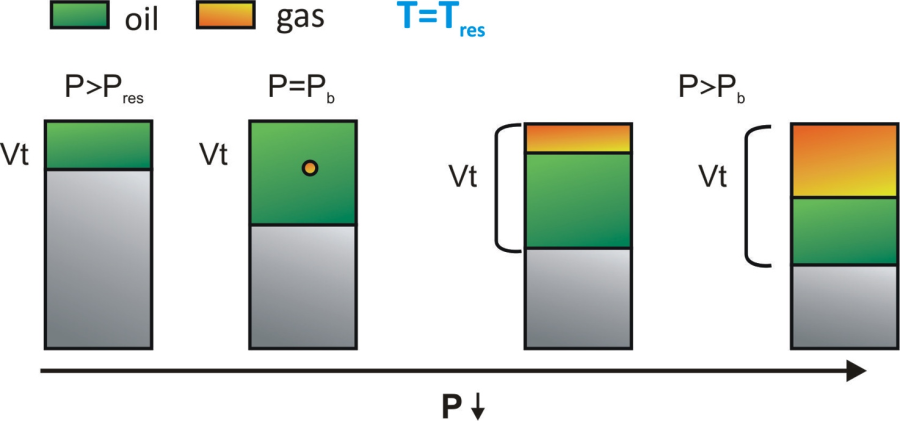
Constant composition expansionA volume of undersaturated oil is expanded in a PV-cell in which all of the fluid is contained within the cell during a series of pressure decrements: usually from the initial pressure (or above) to the bubble point. (Fig. 3.2.2.).

Fig. 3.2.2. Constant composition expansion
After each pressure step, the oil volume is measured and reported as a relative volume (RV):
RV=VVb
In which Vb is the volume at the bubble point. From inspection it will be apparent that the RV is necessarily less than unity and decreases with increasing pressure. Oil density and compressibility are also reported. The bubble point pressure is manifest, as described above, by the sudden large change in volume for a small change in pressure, due to the evolution of high compressibility gas. Differential vaporization experimentThe differential vaporization experiment defines the changing FVF and solution GOR below the bubble point pressure. Gas saturated oil is charged to a PV-cell and the pressure is reduced in steps below the bubble point; after each, the evolved gas is removed from the cell and its volume measured along with the volume of gas saturated oil remaining in the cell. Once the pressure has been reduced to atmospheric, the temperature is decreased from the reservoir value to 20 oС (60 oF), meaning that the final state is the stock tank condition (14.69 psi, 60 oF), at which the remaining oil in the cell is referred to as the "residual7' volume (stb), to which all oil volumes are related at any stage of depletion. (Fig. 3.2.3.).

Fig. 3.2.3. Differential vaporization experiment
From the volumetric measurements of the oil and gas it is possible to calculate:
Bod – FVF of the oil at each stage of depletion:
Bodk=VokVor
Rsd – corresponding solution GOR:
Rsdk=j=1k∆VgjVor
The subscript «d» relates to the differential experiment. Separator testsThe series of separator tests is required to correct the results of the differential vaporization, which may be regarded as an absolute experiment, for the conditions of gas-oil surface separation applied in the field. Saturated oil is charged to a PV-cell at the bubble point and allowed to expand through separators (single, two, three stage, or more, each operating at different pressures and temperatures) to stock tank conditions (Fig. 3.2.4.).

Fig. 3.2.4. Separator tests
These are referred to as flash expansions to which the subscript «d» is applied. Each experiment will provide different values of:
Bobf – flash FVF of the bubble point oil:
Bobf=VsatVost
Rsif – solution GOR of the bubble point oil:
Rsif=VgscVost
The latter being the sum of the GOR's measured for each stage of separation. The values of these parameters will vary dependent on the number of separator stages applied in each experiment and their operating conditions.
Below the bubble point, the absolute results of the differential vaporization require modification to cater for the effect of the conditions of separation. The required FVF then becomes:
Rsid-RsdBobd=Rsif-RsBobf
Froim which the required GOR (can be evaluated as:
Rs=Rsif-(Rsid-Rsd)BobfBobd
Alternatively, above the bubble point, applying equation:
Bo=VVbBobf
and:
Rs=Rsif=const
These are the values of the FVF and GOR, as functions of pressure. Maximising the STOIIP requires the determination of the optimum conditions of separation for which Bobf and Rsif both have minimum values. It would be both time consuming and expensive to attempt to achieve this optimisation by performing repeated separator flash experiments in the laboratory. Instead, optimisation can best be established by calculation, as described below. |